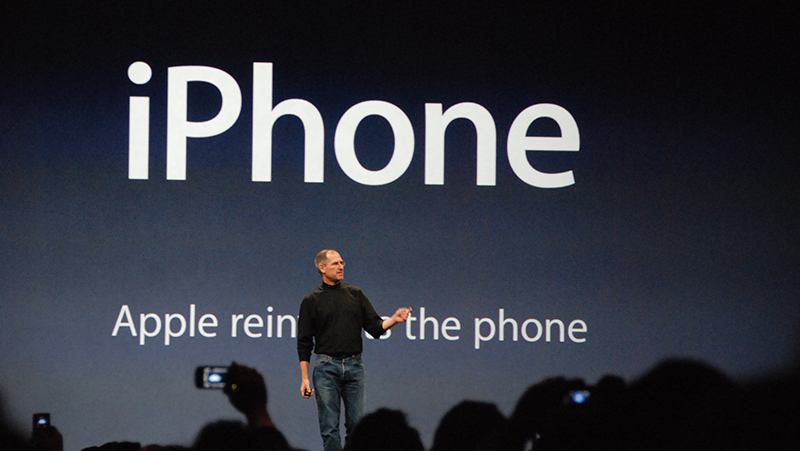The iPhone 10 years on: from innovation to compromise
On the iPhone’s 10th anniversary, we look back at one of the most iconic electronic devices in history

When Steve Jobs, standing on stage at the 2007 Macworld conference in San Francisco, famously proclaimed "Apple is going to reinvent the phone", no one could have guessed the impact his following announcement would have. Apple had gathered the best minds the company could muster, a team of 1,000 engineers, to work in secret on a three-year long mission known internally as 'Project Purple 2'. The culmination of this work would finally be released to the world on 29 June 2007 as the iPhone, setting a standard in mobile design that would remain relatively unchanged for almost a decade.
Project Purple 2
The smartphone market was by no means small in 2007. The likes of Nokia and Motorola were battling it out in the consumer space where calling and texting were still the primary use of mobiles, while Blackberry, Ericsson and Microsoft were attracting business customers to their PDA designs. Rather than compete directly with either, Apple decided to carve out its own space, to offer something that was entirely different.
While not the first mobile device built with a touchscreen (an honour held by the Ericsson R380), the iPhone was the first to eschew a stylus, a physical keyboard, or a navigation panel -mainstays of design until that point. With advanced computing capabilities at the touch of a finger, it redefined our interaction with mobile devices, pioneering a range of features that we would consider industry standards today: multi-touch gestures like 'pinch zooming, predictive typing, glass screens, and gyroscopes for display alignment.
"Considering that in 2002 the Nokia 3510 was the first phone to bring internet services to the mass market, the iPhone disrupted all previous expectations consumers had of what a mobile phone could and should do," says Dale Lovell, CDO and MD at ADYOULIKE. "Since then it has continued to revolutionise mobile technology by creating entirely new products, services and even entire industries, that we couldn't envision just ten years ago."
The phone was powered by a 32-bit ARM-based Samsung processor clocked at 620 MHz, used a fairly beefy 128MB of RAM, and featured a 3.5in screen at a resolution of 320x480 - the only sign of traditional input was a square shaped home button at the bottom. It also came with 4GB or 8GB of storage and a bunch of sensors that meant brightness would be automatically adjusted and the screen would turn off when used for a call. In other words, it was a powerhouse that offered something entirely different to what had come before.
Refining innovation
Yet the 'Jesus Phone', as it was dubbed by some media outlets at the time, was handicapped by a lack of 3G network connectivity, then the fastest connection available. It also lacked video recording, third-party apps, and GPS. Despite the revolutionary design, Apple managed to sell just over 6 million iPhones during its first year, significantly behind the 15 million Nokia achieved with the 6500 Slide or 3110 Classic. The initial concept was there, but it had yet to be the disruptive force that Jobs had envisaged.
The iPhone also had its critics, and while some made claims about longevity and impact that would ultimately prove to be embarrassingly inaccurate, Microsoft's CEO Steve Ballmer perhaps put it best when he said: "You can get a Motorola Q for $99. Apple will have the most expensive phone, by far, in the marketplace. There's no chance that the iPhone is going to get any significant market share."
Get the ITPro daily newsletter
Sign up today and you will receive a free copy of our Future Focus 2025 report - the leading guidance on AI, cybersecurity and other IT challenges as per 700+ senior executives
While he would ultimately be proved wrong, Ballmer did hit on the fact that the market at the time wasn't ready for such an expensive device, regardless of how revolutionary it was. Apple recognised this, and with the launch of the iPhone 3G, cut the contract price from $499 to $199. Alongside the addition of 3G connectivity, this helped the iPhone 3G leapfrog to the number one best seller spot in 2008.
Although today's iPhone, currently the iPhone 7, stands in stark contrast to Apple's original model, with the latest graphical and processing chips and a resolution that dwarfs its predecessors, the fundamental design philosophy has remained unchanged over the last 10 years. It's still entirely screen-centric and every new iteration has made it easier and more enjoyable to use a touchscreen as the primary input. Its iconic design has turned it into one of the most recognised electronic devices on the planet, with over 1 billion iPhones sold to date.
Dale Walker is a contributor specializing in cybersecurity, data protection, and IT regulations. He was the former managing editor at ITPro, as well as its sibling sites CloudPro and ChannelPro. He spent a number of years reporting for ITPro from numerous domestic and international events, including IBM, Red Hat, Google, and has been a regular reporter for Microsoft's various yearly showcases, including Ignite.
-
 Cleo attack victim list grows as Hertz confirms customer data stolen
Cleo attack victim list grows as Hertz confirms customer data stolenNews Hertz has confirmed it suffered a data breach as a result of the Cleo zero-day vulnerability in late 2024, with the car rental giant warning that customer data was stolen.
By Ross Kelly
-
 Lateral moves in tech: Why leaders should support employee mobility
Lateral moves in tech: Why leaders should support employee mobilityIn-depth Encouraging staff to switch roles can have long-term benefits for skills in the tech sector
By Keri Allan